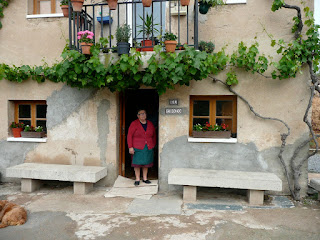 |
| In front of the León Cathedral, from left: Sandy (thin from miles of walking), Bart, Mr. Steves, John. Bottom: Jackie. |
 |
| Mid-13th century Cathedral de Santa Maria de León, one of Europe's finest examples of High Gothic |
The night started at 9:00 with tapas at a series of bars just below the amazing cathedral (more on that later). The streets were already filling with families, grandparents, and small groupings of young people. After a relaxing couple of hours snacking on tapas, we began to worry about whether anything would be open for dinner. We decided to head to head to the Plaza Mayor and discovered that the restaurants were only just now opening. We enjoyed an even more relaxed dinner of menu del peregrino, and by midnight were surprised to discover that the streets were becoming even more crowded! Doors in some of the narrowest alleys now were opening, to expose bar after bar, club after club, disco after disco. The age group in the streets now consisted mostly of people in their 20's and 30's and clearly we were in party central.
There was no curfew at our hotel and, since your pilgrimage guide was of course the first one back to his room, he has no idea when the others made it in. Except that Alison, Jackie, Jeanne, and John had a pretty tough time getting up the next day for our tours of local churches!
| 11th century Basilica of San Isidoro, whose frescoes are one of Spain's medieval treasures |
After lunch we sat at a cafe near the cathedral and began to plot the next stages of our journey. After León we recognize that we were set for about 8 kms of walking through bleak suburbs to get back into the countryside. We agreed that our goal is to walk the whole Camino, so no buses or cabs for us. We'd brave the entire walk no matter how grim. We looked ahead in our guidebooks to the next big city -- Astorga, and identified this as our next likely overnight. At Astorga we would begin the climb over our final mountain range, the Montañas de Leon.
(Congrats to our walkers, whose totals now have allowed us another 120 kilometers, meaning this week we'll be just short of Galicia, the semi-autonomous jurisdiction of which Santiago de Compostela is capitol. Team Charles is leading the way with a total of 348 miles with Team John pulling up the rear with 314).
























